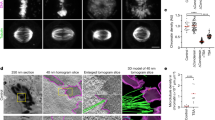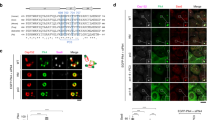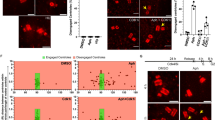Abstract
Old and newly synthesized centrosomes have different microtubule nucleating abilities and they contribute to cell polarity when they migrate to opposite poles during cell division. The asymmetric localization of epigenetic marks and kinetochore proteins could lead to the differential recognition of sister chromatids and the biased segregation of DNA strands to daughter cells during cell division. We propose that this asymmetric localization is linked to biased chromatid segregation, which might also be related to the acquisition of distinct cell fates after mitosis.
This is a preview of subscription content, access via your institution
Access options
Subscribe to this journal
Receive 12 print issues and online access
$189.00 per year
only $15.75 per issue
Buy this article
- Purchase on Springer Link
- Instant access to full article PDF
Prices may be subject to local taxes which are calculated during checkout



Similar content being viewed by others
References
Knoblich, J. A. Mechanisms of asymmetric stem cell division. Cell 132, 583–597 (2008).
Uzbekov, R. & Prigent, C. Clockwise or anticlockwise? Turning the centriole triplets in the right direction! FEBS Lett. 581, 1251–1254 (2007).
Piel, M., Meyer, P., Khodjakov, A., Rieder, C. L. & Bornens, M. The respective contributions of the mother and daughter centrioles to centrosome activity and behavior in vertebrate cells. J. Cell Biol. 149, 317–330 (2000).
Bettencourt-Dias, M. & Glover, D. M. Centrosome biogenesis and function: centrosomics brings new understanding. Nature Rev. Mol. Cell Biol. 8, 451–463 (2007).
Yamashita, Y. M., Mahowald, A. P., Perlin, J. R. & Fuller, M. T. Asymmetric inheritance of mother versus daughter centrosome in stem cell division. Science 315, 518–521 (2007).
Pereira, G., Tanaka, T. U., Nasmyth, K. & Schiebel, E. Modes of spindle pole body inheritance and segregation of the Bfa1p–Bub2p checkpoint protein complex. EMBO J. 20, 6359–6370 (2001).
Klar, A. J. Differentiated parental DNA strands confer developmental asymmetry on daughter cells in fission yeast. Nature 326, 466–470 (1987).
Klar, A. J. The developmental fate of fission yeast cells is determined by the pattern of inheritance of parental and grandparental DNA strands. EMBO J. 9, 1407–1415 (1990).
Klar, A. J. Lessons learned from studies of fission yeast mating-type switching and silencing. Annu. Rev. Genet. 41, 213–236 (2007).
Armakolas, A. & Klar, A. J. Cell type regulates selective segregation of mouse chromosome 7 DNA strands in mitosis. Science 311, 1146–1149 (2006).
Liu, P., Jenkins, N. A. & Copeland, N. G. Efficient Cre–loxP-induced mitotic recombination in mouse embryonic stem cells. Nature Genet. 30, 66–72 (2002).
Cairns, J. Mutation selection and the natural history of cancer. Nature 255, 197–200 (1975).
Klar, A. J. A model for specification of the left–right axis in vertebrates. Trends Genet. 10, 392–396 (1994).
Lansdorp, P. M. Immortal strands? Give me a break. Cell 129, 1244–1247 (2007).
Tajbakhsh, S. Stem cell identity and template DNA strand segregation. Curr. Opin. Cell Biol. 20, 716–722 (2008).
Yamashita, Y. M., Jones, D. L. & Fuller, M. T. Orientation of asymmetric stem cell division by the APC tumor suppressor and centrosome. Science 301, 1547–1550 (2003).
Stevens, N. R., Raposo, A. A., Basto, R., St. Johnston, D. & Raff, J. W. From stem cell to embryo without centrioles. Curr. Biol. 17, 1498–1503 (2007).
Varmark, H. et al. Asterless is a centriolar protein required for centrosome function and embryo development in Drosophila. Curr. Biol. 17, 1735–1745 (2007).
Basto, R. et al. Flies without centrioles. Cell 125, 1375–1386 (2006).
Gonzalez, C. Centrosome function during stem cell division: the devil is in the details. Curr. Opin. Cell Biol. 20, 694–698 (2008).
Rusan, N. M. & Rogers, G. C. Centrosome function: Sometimes less is more. Traffic 10, 472–481 (2009).
Basto, R. et al. Centrosome amplification can initiate tumorigenesis in flies. Cell 133, 1032–1042 (2008).
Castellanos, E., Dominguez, P. & Gonzalez, C. Centrosome dysfunction in Drosophila neural stem cells causes tumors that are not due to genome instability. Curr. Biol. 18, 1209–1214 (2008).
Rebollo, E. et al. Functionally unequal centrosomes drive spindle orientation in asymmetrically dividing Drosophila neural stem cells. Dev. Cell 12, 467–474 (2007).
Rusan, N. M. & Peifer, M. A role for a novel centrosome cycle in asymmetric cell division. J. Cell Biol. 177, 13–20 (2007).
Stewart, E. J., Madden, R., Paul, G. & Taddei, F. Aging and death in an organism that reproduces by morphologically symmetric division. PLoS Biol. 3, e45 (2005).
Gitai, Z., Dye, N. A., Reisenauer, A., Wachi, M. & Shapiro, L. MreB actin-mediated segregation of a specific region of a bacterial chromosome. Cell 120, 329–341 (2005).
Huitema, E., Pritchard, S., Matteson, D., Radhakrishnan, S. K. & Viollier, P. H. Bacterial birth scar proteins mark future flagellum assembly site. Cell 124, 1025–1037 (2006).
Lam, H., Schofield, W. B. & Jacobs-Wagner, C. A landmark protein essential for establishing and perpetuating the polarity of a bacterial cell. Cell 124, 1011–1023 (2006).
White, M. A., Eykelenboom, J. K., Lopez-Vernaza, M. A., Wilson, E. & Leach, D. R. Non-random segregation of sister chromosomes in Escherichia coli. Nature 455, 1248–1250 (2008).
Lew, D. J., Burke, D. J. & Dutta, A. The immortal strand hypothesis: how could it work? Cell 133, 21–23 (2008).
Bowman, G. R. et al. A polymeric protein anchors the chromosomal origin/ParB complex at a bacterial cell pole. Cell 134, 945–955 (2008).
Sinclair, D. A. & Guarente, L. Extrachromosomal rDNA circles — a cause of aging in yeast. Cell 91, 1033–1042 (1997).
Shcheprova, Z., Baldi, S., Frei, S. B., Gonnet, G. & Barral, Y. A mechanism for asymmetric segregation of age during yeast budding. Nature 454, 728–734 (2008).
Karpowicz, P. et al. The germline stem cells of Drosophila melanogaster partition DNA non-randomly. Eur. J. Cell Biol. 88, 397–408 (2009).
Pimpinelli, S. & Ripoll, P. Nonrandom segregation of centromeres following mitotic recombination in Drosophila melanogaster. Proc. Natl Acad. Sci. USA 83, 3900–3903 (1986).
Cairns, J. Cancer and the immortal strand hypothesis. Genetics 174, 1069–1072 (2006).
Rando, T. A. The immortal strand hypothesis: segregation and reconstruction. Cell 129, 1239–1243 (2007).
Rossi, D. J. et al. Deficiencies in DNA damage repair limit the function of haematopoietic stem cells with age. Nature 447, 725–729 (2007).
Fei, J. F. & Huttner, W. B. Nonselective sister chromatid segregation in mouse embryonic neocortical precursor cells. Cereb. Cortex 19, i49–i54 (2009).
Kiel, M. J. et al. Haematopoietic stem cells do not asymmetrically segregate chromosomes or retain BrdU. Nature 449, 238–242 (2007).
Sotiropoulou, P. A., Candi, A. & Blanpain, C. The majority of multipotent epidermal stem cells do not protect their genome by asymmetrical chromosome segregation. Stem Cells 26, 2964–2973 (2008).
Waghmare, S. K. et al. Quantitative proliferation dynamics and random chromosome segregation of hair follicle stem cells. EMBO J. 27, 1309–1320 (2008).
Shinin, V., Gayraud-Morel, B., Gomes, D. & Tajbakhsh, S. Asymmetric division and cosegregation of template DNA strands in adult muscle satellite cells. Nature Cell Biol. 8, 677–682 (2006).
Karpowicz, P. et al. Support for the immortal strand hypothesis: neural stem cells partition DNA asymmetrically in vitro. J. Cell Biol. 170, 721–732 (2005).
Conboy, M. J., Karasov, A. O. & Rando, T. A. High incidence of non-random template strand segregation and asymmetric fate determination in dividing stem cells and their progeny. PLoS Biol. 5, e102 (2007).
Bailey, S. M., Goodwin, E. H., Meyne, J. & Cornforth, M. N. CO-FISH reveals inversions associated with isochromosome formation. Mutagenesis 11, 139–144 (1996).
Bell, C. D. Is mitotic chromatid segregation random? Histol. Histopathol. 20, 1313–1320 (2005).
Jablonka, P. & Jablonka, E. Non-random sister chromatid segregation by cell type. J. Theor. Biol. 99, 427–436 (1982).
Patkin, E. L. Epigenetic mechanisms for primary differentiation in mammalian embryos. Int. Rev. Cytol. 216, 81–129 (2002).
Blow, J. J. & Hodgson, B. Replication licensing — defining the proliferative state? Trends Cell Biol. 12, 72–78 (2002).
Henikoff, S. Nucleosome destabilization in the epigenetic regulation of gene expression. Nature Rev. Genet. 9, 15–26 (2008).
Probst, A. V., Dunleavy, E. & Almouzni, G. Epigenetic inheritance during the cell cycle. Nature Rev. Mol. Cell Biol. 10, 192–206 (2009).
Burhans, W. C. et al. Emetine allows identification of origins of mammalian DNA replication by imbalanced DNA synthesis, not through conservative nucleosome segregation. EMBO J. 10, 4351–4360 (1991).
Weintraub, H., Worcel, A. & Alberts, B. A model for chromatin based upon two symmetrically paired half-nucleosomes. Cell 9, 409–417 (1976).
Ekwall, K. Epigenetic control of centromere behaviour. Annu. Rev. Genet. 41, 63–81 (2007).
Malik, H.S. & Henikoff, S. Major evolutionary transitions in centromere complexity. Cell 138, 1067–1082 (2009).
Thorpe, P. H., Bruno, J. & Rothstein, R. Kinetochore asymmetry defines a single yeast lineage. Proc. Natl Acad. Sci. USA 106, 6673–6678 (2009).
Pardo- Manuel de Villena, F. & Sapienza, C. Nonrandom segregation during meiosis: the unfairness of females. Mamm. Genome 12, 331–339 (2001).
Grava, S., Schaerer, F., Faty, M., Philippsen, P. & Barral, Y. Asymmetric recruitment of dynein to spindle poles and microtubules promotes proper spindle orientation in yeast. Dev. Cell 10, 425–439 (2006).
Higuchi, T. & Uhlmann, F. Stabilization of microtubule dynamics at anaphase onset promotes chromosome segregation. Nature 433, 171–176 (2005).
Liakopoulos, D., Kusch, J., Grava, S., Vogel, J. & Barral, Y. Asymmetric loading of Kar9 onto spindle poles and microtubules ensures proper spindle alignment. Cell 112, 561–574 (2003).
Louie, R. K. et al. Adenomatous polyposis coli and EB1 localize in close proximity of the mother centriole and EB1 is a functional component of centrosomes. J. Cell Sci. 117, 1117–1128 (2004).
Armakolas, A. & Klar, A. J. Left–right dynein motor implicated in selective chromatid segregation in mouse cells. Science 315, 100–101 (2007).
Maiato, H., Rieder, C. L. & Khodjakov, A. Kinetochore-driven formation of kinetochore fibers contributes to spindle assembly during animal mitosis. J. Cell Biol. 167, 831–840 (2004).
Kapoor, T. M. et al. Chromosomes can congress to the metaphase plate before biorientation. Science 311, 388–391 (2006).
Volpe, T. A. et al. Regulation of heterochromatic silencing and histone H3 lysine-9 methylation by RNAi. Science 297, 1833–1837 (2002).
Fuchs, E., Tumbar, T. & Guasch, G. Socializing with the neighbors: stem cells and their niche. Cell 116, 769–778 (2004).
Wilson, A. et al. Hematopoietic stem cells reversibly switch from dormancy to self-renewal during homeostasis and repair. Cell 135, 1118–1129 (2008).
Potten, C. S. & Booth, C. Keratinocyte stem cells: a commentary. J. Invest. Dermatol. 119, 888–899 (2002).
Barker, N. et al. Identification of stem cells in small intestine and colon by marker gene Lgr5. Nature 449, 1003–1007 (2007).
Luders, J. & Stearns, T. Microtubule-organizing centres: a re-evaluation. Nature Rev. Mol. Cell Biol. 8, 161–167 (2007).
Carmena, M. & Earnshaw, W. C. The cellular geography of aurora kinases. Nature Rev. Mol. Cell Biol. 4, 842–854 (2003).
Chang, P. & Stearns, T. Δ-tubulin and ɛ-tubulin: two new human centrosomal tubulins reveal new aspects of centrosome structure and function. Nature Cell Biol. 2, 30–35 (2000).
Acknowledgements
S.T. would like to acknowledge support from the Institut Pasteur, Agence Nationale de la Recherche, EuroSystem (EU FP7) and the Fondation pour la Recherche Medicale. C.G.'s laboratory is supported by the European Union (ONCASYM-037398 FP6), the Spanish government (BFU2009-07975, Consolider-Ingenio2010 CENTROSOME_3D) and Generalitat de Catalunya (23SGR2005).
Author information
Authors and Affiliations
Supplementary information
41580_2009_BFnrm2784_MOESM2_ESM.pdf
Supplementary information S1 (Box) | Stem cell self-renewal and altruistic suicide – a dual role for centrosomes? (PDF 609 kb)
Related links
Rights and permissions
About this article
Cite this article
Tajbakhsh, S., Gonzalez, C. Biased segregation of DNA and centrosomes — moving together or drifting apart?. Nat Rev Mol Cell Biol 10, 804–810 (2009). https://doi.org/10.1038/nrm2784
Issue Date:
DOI: https://doi.org/10.1038/nrm2784
This article is cited by
-
Centrosomes in spindle organization and chromosome segregation: a mechanistic view
Chromosome Research (2016)
-
Chromosome-specific nonrandom sister chromatid segregation during stem-cell division
Nature (2013)
-
Sorting DNA with asymmetry: a new player in gene regulation?
Chromosome Research (2013)
-
Selective tracking of template DNA strands after induction of mitosis with unreplicated genomes (MUGs) in Drosophila S2 cells
Chromosome Research (2013)
-
Asymmetric distribution of histones during Drosophila male germline stem cell asymmetric divisions
Chromosome Research (2013)



